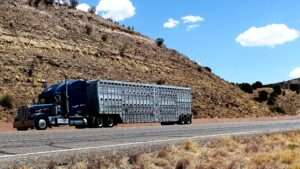Essential Equipment Used by Truck Drivers: A Comprehensive Guide
Introduction
Truck driving is not an easy task, and it requires a lot of preparation and planning. One of the most critical factors for truck drivers is to have the right equipment to ensure that they are safe and productive on the road. Whether it’s for personal safety, cargo protection, or improving driving efficiency, having the proper equipment is essential. Truck drivers need a variety of tools and gear to navigate their routes, secure their loads, and communicate with other drivers and dispatchers. Some of the most essential equipment used by truck drivers are GPS navigation systems, CB radios, electronic logging devices, load securement equipment, and maintenance tools.
With GPS navigation systems, truck drivers can quickly and easily navigate to their destinations, avoiding traffic jams, and finding the most efficient routes. CB radios are critical for communicating with other drivers and dispatchers, particularly in areas with limited cellular coverage. Electronic logging devices help truck drivers to stay compliant with federal regulations and track their hours of service accurately. Load securement equipment helps to protect cargo and ensure that it doesn’t shift during transport, which could cause accidents.
In this article, we’ll delve into each of these equipment types in more detail and explain why they are essential for truck drivers. By the end of this article, you’ll have a better understanding of the essential equipment needed for a successful trucking career.

- Standalone GPS Navigation Systems
- CB radios
- A small toolbox
- Electronic logging devices (ELDs)
- Dashcams
- Load securement equipment
- Hand trucks and dollies
- Tarpaulins
- Safety gear
- Maintenance tools
Standalone GPS Navigation Systems
Standalone GPS navigation systems are designed specifically for truck drivers and offer a wide range of advanced features that can make your journey safer and more efficient. These devices typically come with larger screens and more detailed maps than smartphone apps, making it easier to navigate complex routes and highways. One of the key advantages of standalone GPS navigation systems is their accuracy. These devices use dedicated GPS receivers that can pick up signals from multiple satellites, ensuring that you always have precise location and route information. Some standalone GPS systems also come with built-in dashcams, which can help you record your journey and provide evidence in case of an accident or dispute.
Another advantage of standalone GPS systems is their durability. These devices are built to withstand the harsh conditions of trucking, with rugged casings and waterproof designs that can handle bumps, drops, and exposure to the elements. Many standalone GPS systems also come with long-lasting batteries that can provide up to 10 hours of continuous use, ensuring that you never run out of power when you need it most. So. its an important equipment used by truck drivers. These equipment are essential for the safety of truck drivers also.
CB Radios
CB radios are a reliable form of communication that allows truck drivers to stay connected with other drivers on the road. They operate on a shared frequency, allowing multiple users to communicate with each other simultaneously. This is particularly useful when traveling in convoys or when you need to coordinate with other drivers on the road. One of the biggest benefits of CB radios is that they provide real-time updates on traffic conditions and road hazards. This information can be critical in helping you avoid accidents and delays, and can also help you plan your route more efficiently. For example, if you hear that there is a major accident ahead, you can take an alternate route to avoid the congestion.
Another benefit of CB radios is that they can provide updates on weather conditions and emergency situations. This can be particularly useful when driving in areas prone to severe weather, such as tornadoes or hurricanes. By staying informed of weather conditions, you can make informed decisions about when to stop and when to continue driving. Finally, CB radios can also be a source of entertainment and companionship for truck drivers. Long hours on the road can be lonely, and having the ability to chat with other drivers can help break up the monotony of the journey.
A Small Toolbox
A small toolbox typically contains a set of essential tools that can be used to fix minor issues or perform basic maintenance tasks. For example, screwdrivers can be used to remove panels or adjust mirrors, while pliers can be used to grip and hold small parts. Wrenches are essential for tightening or loosening bolts and nuts, while a tire pressure gauge can help you monitor your tire pressure and prevent blowouts or other tire-related issues. Aside from basic tools, your toolbox should also include a few spare parts such as fuses, belts, and hoses. These parts can help you perform quick repairs on the go, saving you valuable time and money. For example, if your truck’s fan belt breaks, having a spare one in your toolbox can help you fix the issue without having to call a mechanic or wait for a tow truck.
Overall, having a small toolbox in your truck can provide you with peace of mind knowing that you are prepared for any unexpected situations that may arise. By investing in a set of essential tools and spare parts, you can increase your safety and productivity on the road, and ensure that you are always ready to tackle any challenge that comes your way. The equipment used by truck drivers can make a big difference in their ability to handle unforeseen circumstances while on the road.

Electronic Logging Devices (ELDs)
ELDs are an important piece of equipment used by truck drivers for ensuring compliance with federal regulations on rest and break times. These devices automatically record driving time and hours of service, eliminating the need for drivers to manually keep paper logs. This helps to prevent fatigue-related accidents by ensuring that drivers take adequate rest and breaks before getting back on the road. ELDs are also designed to improve accuracy and efficiency. They provide real-time data on driving time and hours of service, allowing drivers and carriers to better manage their time and schedule. This can help to reduce delays and improve productivity, while also ensuring that drivers are not exceeding their driving limits.
In addition to improving safety and efficiency, ELDs are also helping to streamline compliance and reduce administrative burdens for truck drivers. By automating the logging process, drivers and carriers can reduce the risk of errors and reduce the time and effort required to maintain accurate records. This can help to improve compliance with federal regulations and reduce the risk of fines or penalties for non-compliance. Overall, ELDs are an essential piece of equipment used by truck drivers that help to ensure safety, efficiency, and compliance on the road.
Dashcams
Dashcams are one of the equipment used by truck drivers that can be particularly useful. A dashcam is a small camera that is mounted on the dashboard or windshield of a vehicle. It continuously records video footage of the road ahead and stores it on a memory card or hard drive. Some dashcams also have features such as GPS tracking, night vision, and collision detection. For truck drivers, dashcams can help capture footage of an accident or collision, providing evidence that can be used in legal disputes or insurance claims. This can help drivers protect themselves against false accusations or liability claims.
In addition to providing evidence for accidents and collisions, dashcams can also help drivers improve their driving habits. Some dashcams have features that can detect unsafe driving behaviors such as sudden stops, hard braking, or swerving. Drivers can use this information to identify areas where they need to improve and become safer drivers overall. Furthermore, dashcams can help prevent fraud. Other drivers or pedestrians may try to stage an accident in order to collect insurance payouts or file false claims. With a dashcam, drivers can capture footage of these incidents and prove that they were not at fault.
Load Securement Equipment
Truck drivers rely on various types of equipment for load securement, which is a crucial aspect of their job. The proper use of load securement equipment is vital for ensuring that cargo remains in place during transport and preventing accidents on the road. When cargo is not adequately secured, it can shift or fall off the truck, leading to significant damage to both the goods and the vehicle. In some cases, unsecured cargo can also cause accidents and injuries.
The equipment used by truck drivers for load securement includes tie-down straps, chains and binders, bungee cords, and tarps. Tie-down straps are commonly used and are made from heavy-duty webbing that can secure a variety of items, including pallets, crates, and machinery. Chains and binders are suitable for securing heavy items like steel or concrete, as they are made from high-strength materials that can withstand significant tension and pressure. Bungee cords are essential for securing smaller items, such as boxes or bags, while tarps are used to cover and protect larger items like furniture or appliances.
It is crucial for truck drivers to comply with load securement regulations set by the Federal Motor Carrier Safety Administration (FMCSA). These regulations specify the minimum number of tie-downs required for different types of cargo and the maximum weight allowed per tie-down. Failure to comply with these regulations can result in fines, penalties, and even the suspension of a driver’s license.
Hand Trucks and Dollies
Truck drivers need to load and unload cargo from their trucks, and for this reason, they use various types of equipment to make their job easier. One of the most common pieces of equipment used by truck drivers is a hand truck or dolly. A hand truck, also known as a sack truck or dolly, is a device that has two wheels and a handle for pushing or pulling heavy or bulky items. There are different types of hand trucks available for truck drivers, including platform trucks and hand carts. Platform trucks are designed to carry large or bulky items, such as furniture or appliances, and typically have a flat platform and four wheels for stability. Hand carts, on the other hand, are more compact and designed for smaller items, and typically have two wheels and a smaller platform. Another type of hand truck used by truck drivers is a stair-climbing dolly, which has special wheels that can climb stairs, making it easier to move heavy items up and down stairs. By using this equipment, truck drivers can avoid putting unnecessary stress on their bodies, reducing the risk of injury and making their job safer and more comfortable.

Tarpaulins
Flatbed tarps are designed to cover flatbed trailers and can be secured with bungee cords, straps, or ropes. They are usually made of heavy-duty vinyl or polyester material and come in various sizes to fit different trailer sizes. Flatbed tarps are used to protect a variety of cargo, including machinery, building materials, and other oversized items. Lumber tarps are designed specifically to cover loads of lumber and other long and bulky items. They are typically made of heavy-duty vinyl material and have flaps that can be secured around the edges of the trailer using bungee cords or straps. Lumber tarps can be customized to fit specific trailer sizes and can come with additional features such as pockets for storing straps and bungee cords.
Steel tarps are designed to cover loads of steel and other metal items. They are made of heavy-duty vinyl material and have flaps that can be secured around the edges of the trailer using bungee cords or straps. Steel tarps can also be customized to fit specific trailer sizes and may come with additional features such as reinforced corners or flaps for extra protection. In addition to protecting cargo from the elements, tarpaulins can also help truck drivers comply with regulations for load securement. The Federal Motor Carrier Safety Administration (FMCSA) has strict regulations for load securement, including requirements for using tarps to cover certain types of cargo. By using tarpaulins to secure their cargo, truck drivers can avoid fines and keep themselves and others on the road safe.
Safety Gear
Safety gear is essential for protecting yourself and others on the road. As a truck driver, you are exposed to a wide range of hazards, including inclement weather, hazardous materials, and other drivers on the road. Some of the essential safety gear you should have in your truck include:
Reflective vests: These vests help make you visible to other drivers, especially at night or in low light conditions.
Hard hats: Hard hats can protect your head from falling objects or debris.
Safety glasses: Safety glasses can protect your eyes from dust, debris, and other hazards.
Work gloves: Work gloves can protect your hands from cuts, scrapes, and other injuries.
Steel-toed boots: Steel-toed boots can protect your feet from falling objects and other hazards.
Fire extinguishers: Fire extinguishers can help you quickly extinguish small fires before they become major emergencies.
Maintenance Tools
Finally, every truck driver should have a basic set of maintenance tools in their truck. These tools can help you perform basic repairs and maintenance tasks on your truck, such as changing a tire, replacing a belt, or fixing a leak. Some of the essential maintenance tools you should have in your truck include:
Wrenches and sockets: These tools are essential for removing and tightening bolts and nuts.
Screwdrivers: Screwdrivers can be used for a variety of tasks, such as removing panels, adjusting mirrors, and tightening screws.
Pliers: Pliers are useful for gripping and holding small parts, such as nuts, bolts, and wires.
Tire pressure gauge: A tire pressure gauge can help you monitor your tire pressure and prevent blowouts or other tire-related issues.
Conclusion
As a truck driver, you have a lot of responsibility to ensure that your cargo arrives safely and on time. To do this job well, you need to have the right equipment at your disposal. In this article, we’ve explored some of the essential equipment that every truck driver should have, including GPS navigation systems, CB radios, electronic logging devices, load securement equipment, and more. By investing in these tools and gear, you can improve your safety, efficiency, and productivity on the road, and ensure that you are well-prepared for any situation that may arise.

